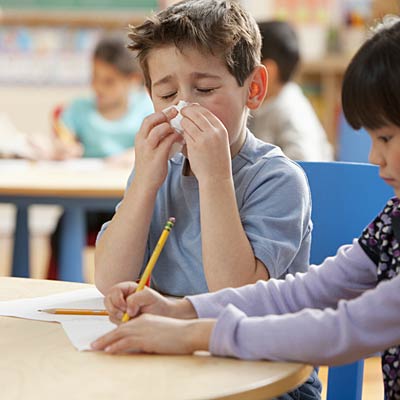
Children in day care or in school can have as many as eight to 12 colds a year, according to the American Academy of Pediatrics
If you think your kids are sick a lot during the school year, that’s because they are. Children in day care or in school can have as many as eight to 12 colds a year, according to the American Academy of Pediatrics. And that’s just respiratory infections. Often colds and other germ-triggered conditions aren’t that serious and symptoms disappear on their own (if they can’t be treated by a doctor). But isn’t it better to prevent them in the first place?
Here’s how to protect your kids from germs that tend to circulate in classrooms.
Conjunctivitis
More commonly called “pink eye” because it can cause the whites of one or both eyes to turn pink, conjunctivitis is transmitted by touching the germy discharge from someone else’s eyes or touching a surface that has been contaminated. The type cased by bacteria is more contagious than the type caused by viruses, but the risk of either can be minimized by hand washing and telling kids to not touch their face unless they’ve washed their hands.
Coxsackievirus
Coxsackievirus infections can cause a number of ailments, chief among them the uncommon, but painful hand, foot, and mouth disease. This causes a nasty rash inside the mouth and on the palms and soles of the feet. There’s no treatment, so go for prevention. The virus lives in the saliva. Make sure kids don’t put objects, especially shared objects like pencils, in their mouths and stress that they need to eat their own lunch, not anyone else’s, says M. Kathryn Sanders, RN, assistant professor at the Texas A&M Health Science Center College of Nursing in Round Rock.
Head lice
Head lice infestation can happen to anyone—and it does. These tough-to-eradicate critters spread from person to person and, most often, with head-to-head contact, says Sanders. If kids are studying in a group, heads huddled together, lice can spread. Lice can also crawl on back packs, sleeping bags, and pillows. Girls should keep long hair up and shorter haircuts can help minimize (but not eliminate) risk, says Sanders. Tell children to avoid head-to-head contact, and not to share combs, hats, or back packs. Too late? Here are 20 Ways to Get Rid of Head Lice.
Impetigo
This skin infection can be caused by Streptococcus or Staphylococcus bacteria and results in pus-filled blisters and open sores that crust over. The bad news is that it is quite contagious, and can be spread by coming into contact with another person, by touching a contaminated surface, or by moving germs from one part of the body to another. The good news is that you actually have to have an open sore or cut for it to infect you, says Sanders. Avoid direct contact with someone who is already infected and keep washing those hands.
Influenza
Coinciding with the start of the school year is the beginning of flu season. Aside from avoiding these surprising risk factors for the flu, the best protection against the seasonal flu is the flu vaccine, which is updated annually. The effectiveness of the vaccine varies from year to year but, according to one study, can be up to 83 percent effective. The Centers for Disease Control and Prevention recommends that all healthy children aged 6 months and older get the vaccine each year.
Measles
Thanks to the highly effective MMR (measles, mumps, rubella) vaccine, measles in children was declared eradicated in the U.S. in 2000. In recent years, though, there have been troubling outbreaks around the country, probably due to a drop in vaccination rates. (Sort out fact from fiction with 12 Myths and Facts about Vaccines.) Vaccination is the key to prevention. In fact, proof of vaccination is often required before a child can start school. The initial shot is given when the child is 12-to-15 months old and another when they reach school age.
Meningitis
This potentially fatal infection of the membranes covering the brain and spinal cord is more common in preteens and teens (it can be a hazard in college dorms) than younger children, and fortunately, is relatively rare. The best way to prevent it is a meningococcal vaccine, which stops some of the major meningitis-causing germs. The CDC recommends all 11-12 year olds be vaccinated then receive a booster dose at age 16. If you notice any symptoms in your child—severe headache, sensitivity to light, neck pain—seek medical attention right away, says Sanders.
Mononucleosis
Known as the “kissing disease,” mononucleosis can be transmitted through kissing and other contact with contaminated saliva. It is most common in teens aged 15 through 17. While it may not be possible to regulate kissing in maturing kids, you can caution them to avoid sharing food, drinks, and utensils. These can spread mono-causing viruses, which can cause fever, swollen glands, sore throat, and fatigue.
Norovirus
You’ve heard about outbreaks of this stomach bug on cruise ships, but it can make the rounds in any crowded space, including schools. The virus is spread through feces so avoid sharing food, drinks, and eating utensils with other people. Washing hands frequently can help. There have been reported instances of contracting norovirus from swimming pools. Tell your kids not to get pool water in their mouth, says Sanders.
Otitis media
Also known as an ear infection, otitis media is common, especially among young children. That’s partly because the structure of the developing ear makes it easier for fluids to get trapped, says Sanders. There’s not much you can do about that, but some childhood immunizations (including influenza and pneumococcal conjugate vaccines) may reduce the risk of ear infections, as can basic hygiene techniques such as washing your hands.
Pertussis
Pertussis, aka whooping cough, is a serious and potentially dangerous respiratory infection caused by Bordetella pertussis bacteria. Infected people spread the bug through coughing, sneezing, or close contact with another person. Vaccines are available for children, teens, and adults—but not babies, who can get life-threatening infections. If your child has a serious cough, see your doctor and, make sure he or she stays home (this goes for all illnesses). Healthy children should be vaccinated and wash their hands often to avoid getting sick.
Rhinovirus
Rhinoviruses are behind most cases of the common cold, which run rampant in schools. Once your child has caught a cold there’s not much you can do except treat the symptoms. To stay healthy, it’s best to encourage hand washing. At a minimum, children should wash their hands or use a hand sanitizer after using the restroom; after they blow their nose; if they cough or sneeze into their hands (tell them to aim for the crook of their arm, instead of hands); and before they eat, says Dr. Andrea Green Hines, a pediatrician at the University of Nebraska Medical Center in Omaha.
Rotavirus
Rotavirus is highly contagious bug that causes diarrhea and can quickly lead to dehydration, especially in small children. But this is another case when a vaccine, given orally when your child is still a baby, can prevent future ailments. The vaccine is not given to older children, so if your child missed the chance, be aware that the virus is spread through feces. To help prevent its spread, make sure diapers are properly disposed of and wash your hands.
Strep throat
Strep throat, caused by infection with groups A streptococcus bacteria, can cause not only severe throat pain, but also fever, headache, nausea, and vomiting. The bug is spread through contact with contaminated saliva, either directly or indirectly through droplets in the air. If a strep test is positive, antibiotics are necessary due to the risk of more serious complication that may affect the heart and brain. Kids of school age shouldn’t share objects and, importantly, shouldn’t stick them in their mouths. Making sure your child has his or her own cool pencil box may help reduce the risk.
Source: Fox news




 The immediate symptoms are vomiting and severe abdominal pain with mostly children mistakenly consuming substances like toilet cleaners or acids kept in mineral water bottles or other daily-use containers, the doctors said.
The immediate symptoms are vomiting and severe abdominal pain with mostly children mistakenly consuming substances like toilet cleaners or acids kept in mineral water bottles or other daily-use containers, the doctors said.


 There are many conditions that, although extremely rare, can cause blindness in a child if not caught on time. One such condition is pediatric glaucoma, which occurs when the pressure in the eye is elevated, causing damage to the optic nerve.
There are many conditions that, although extremely rare, can cause blindness in a child if not caught on time. One such condition is pediatric glaucoma, which occurs when the pressure in the eye is elevated, causing damage to the optic nerve.